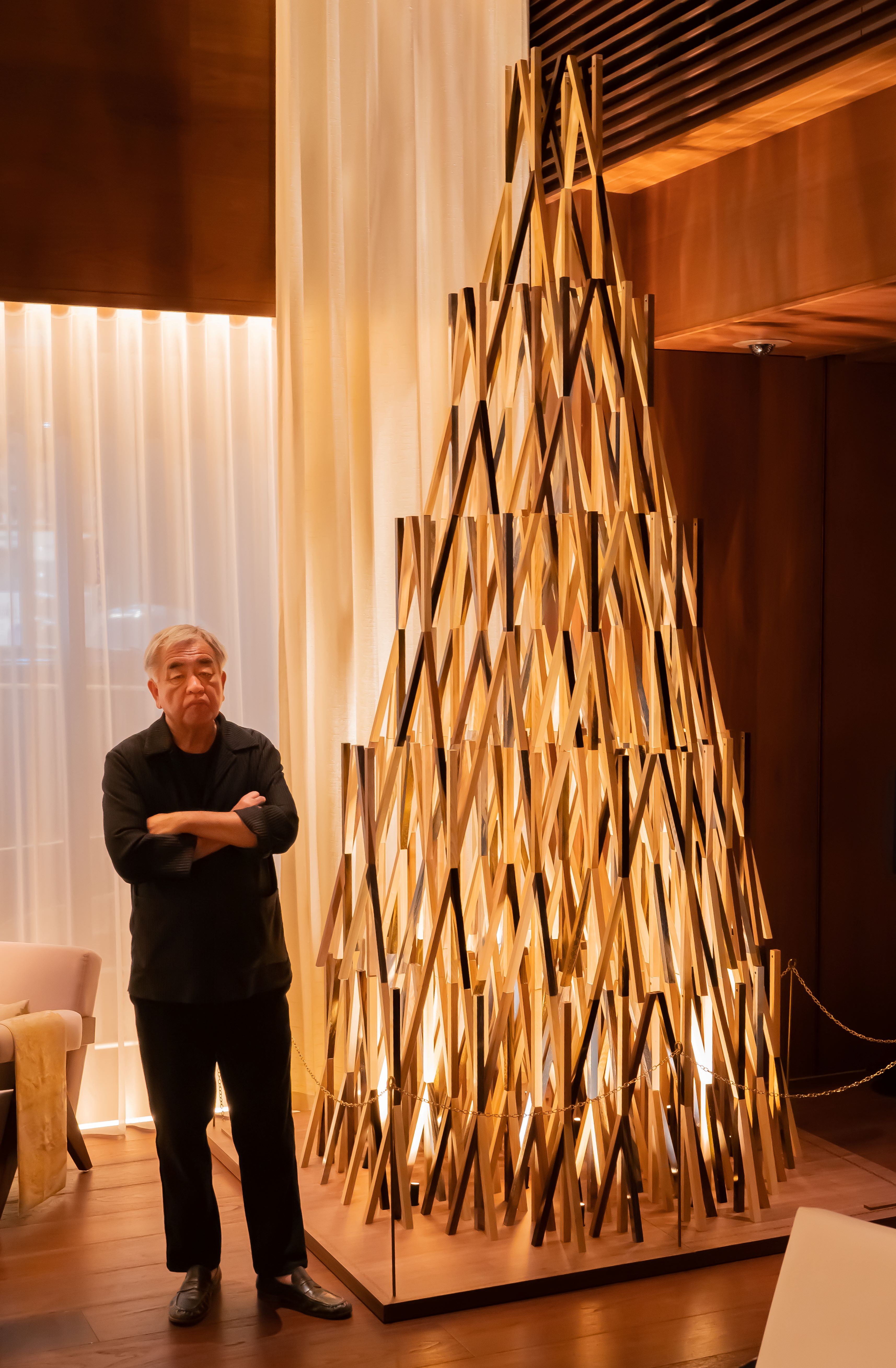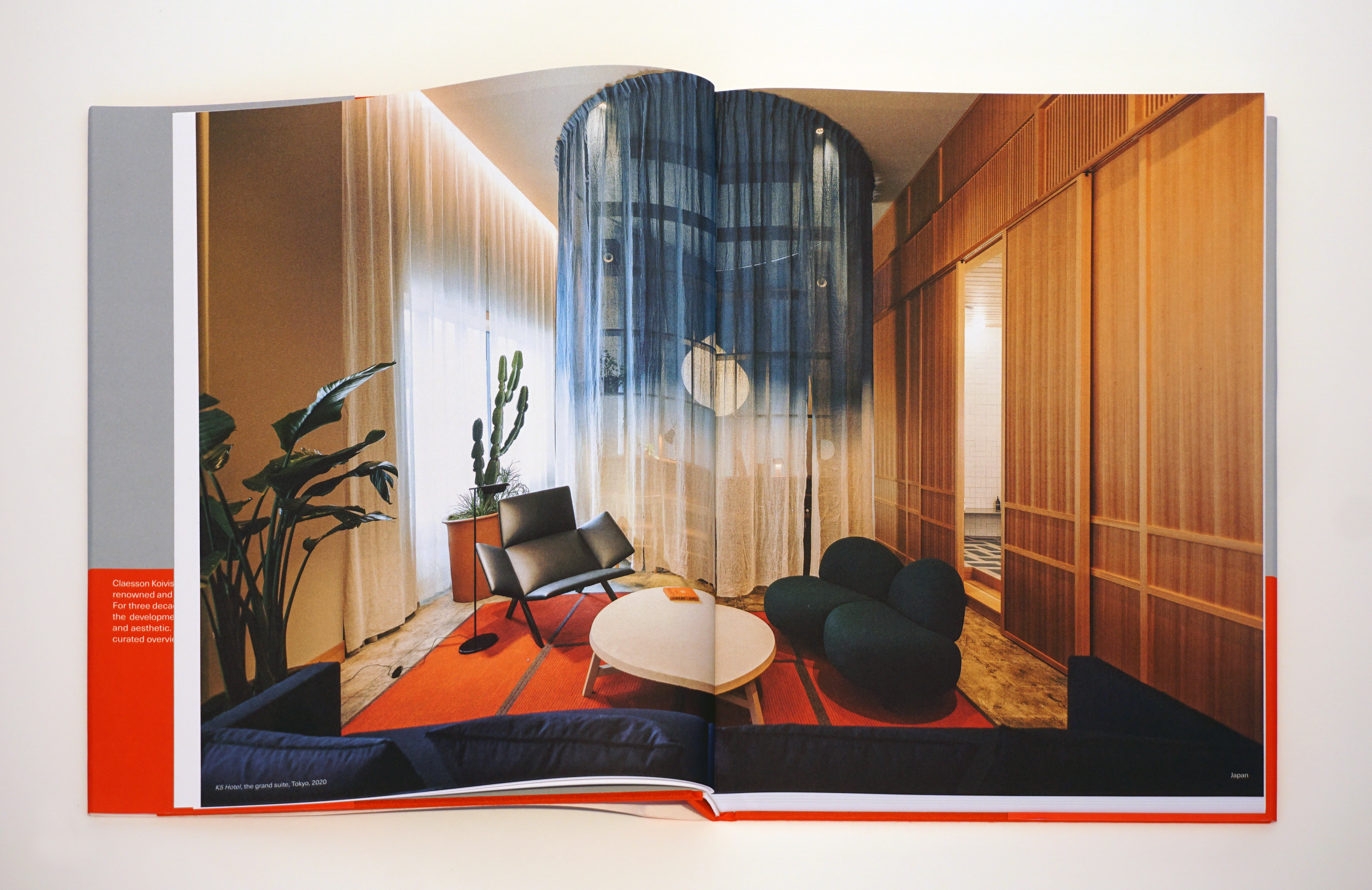Minimal curves and skilled lines are the focal point of Kengo Kuma's Christmas trees
Kengo Kuma unveiled his two Christmas trees, each carefully designed to harmonise with their settings in two hotels he also designed: The Tokyo Edition, Toranomon and The Tokyo Edition, Ginza

Forget baubles and tinsel. When iconic Japanese architect Kengo Kuma decided to design Christmas trees for the first time in his decades-long career, it was maybe no surprise that the material palette was simple, minimal and natural – crafted purely from wood. Kuma this week unveiled his two Christmas trees, each carefully designed to harmonise with their settings in two hotels he also designed: The Tokyo Edition, Toranomon and The Tokyo Edition, Ginza.
This being Kuma, these are no typical Christmas trees. The creations are made up of minimal curves and lines by skilled craftsmen from respected Japanese woodmakers Karimoku, in a medley of quality woods (oak, magnolia, walnut, maple) – and, in a sustainable festive twist, after Christmas, the trees will be dismantled and transformed into furniture.

Kengo Kuma by Ginza Christmas Tree
At The Tokyo Edition, Toranomon, the tree is centre stage in the cloud-brushing 31st floor lobby. Here, among green leafy plants, minimalist wooden Kuma-designed eaves and sweeping skyscraper views, the 2.8m high tree – called Komorebi, a word referring to sunlight filtering through treetops – is made up of countless wooden circles.
These rings are connected by small hidden popper buttons so they can easily be attached, removed and arranged in an array of formations, in stacked units. Adding further depth, some rings are empty, while others contain discs of wood or mirrors, evoking a reflective sense of light, both during the day and after dark. Following its festive moment in the spotlight, this tree will be transformed into units of furniture – tables made up of a circular glass table-top, sitting on a trio of rings. One special table will be created from the rings that form the 'star' apex of the tree, which includes a trio of rings coated in gold.

Ginza Christmas Tree
The festive atmosphere shifts a short distance away at The Tokyo Edition, Ginza, where a very different tree called Kigumi – a word referring to nail-free Japanese joinery – sits in the hotel’s intimate dark walnut-panneled lobby on the ground floor.
This tree consists of countless thin vertical sticks in a variety of wood textures, with a scattering finished in silver and bronze metal paints, evoking a sharply elegant atmosphere. These components can be smoothly interlocked into tall thin stacks of three pieces of wood – which are then connected collectively to form a Christmas tree, with its angular lines echoing the weaving-like effect of the latticed façade of the hotel, also designed by Kuma.

Ginza furniture rendering
The Ginza tree will also be dismantled and transformed into tables, with tall stacks of wood sitting beneath a circular tabletop of walnut. All the furniture will sell online, while two special tables made from with the apexes of the two trees will be sold via a silent auction.
Receive our daily digest of inspiration, escapism and design stories from around the world direct to your inbox.
Here, Kuma talks to Wallpaper* about his Christmas tree project – from its inspirations and craftsmanship to its wooden material palette.
Kengo Kuma unwraps the creative inspiration behind his Christmas tree project

Prototype Toranomon Komorebi Table by Karimoku
Wallpaper*: What’s the idea behind this project?
Kengo Kuma: Christmas trees are usually displayed indoors, but they can also be placed in the garden. In this project we interpreted the Edition hotels as the garden, and aimed to design a friendly space respectively, where people can relax with the tree as the main attraction.
W*: What connects the two tree designs in Ginza and Toranomon – and what differentiates them?
KK: In the Toranomon hotel, we used wood with sharp-edged designs in the architecture. To complement the sharpness of the design, we came up with a round, soft geometry for the tree. To the contrary, in Ginza, wood is used basically at 90 degrees in terms of the geometry, so we designed the tree with the pointed tip to add natural sharpness in the architecture.

Kengo Kuma
W*: How did the idea of turning the trees into furniture come about and how will they be reborn?
KK: These Christmas trees won’t be thrown away after the event, but are to be dismantled and recycled as furniture, in order for them to live a much longer time. We wanted to use wooden materials so that people visiting there could feel the cycle of nature behind the Christmas trees.

Progress sketches by Kengo Kuma
W*: Can you tell me about your relationship with Karimoku – and the appeal of working together?
KK: Karimoku is a company who knows the nature of wood and has inherited a high-level of craftsmanship. We work with them often. The trees in this project required techniques to achieve great strength while using small and thin members. They did a wonderful job that could not be done by anyone else.
W*: Which woods were used?
KK: Oak from Tohoku, Sen from Hokkaido, Magnolia from Gifu, Japanese walnut from Tohoku, Itaya Maple from Hokkaido. And only for Ginza, walnut from North America.

Toranomon Christmas Tree during the day
W*: Can you explain the sustainability elements, in terms of both material and concept?
KK: In Japan, it has been a problem that tree plantations had been leaning toward coniferous trees, causing an imbalance with broadleaf trees that could affect the natural environment. We wanted to raise awareness by using broadleaf trees.

Prototype Ginza Kigumi Desk by Karimoku
W*: Finally, what imprint do you hope these trees will leave on hotel visitors during the festive season and beyond?
KK: In addition to the trees, visitors would recognise wooden material is used throughout the interior of the two hotels – I would like them to be aware that wood is essential in our daily life, and extend their imagination further to the forests behind the trees.
https://www.editionhotels.com/tokyo-toranomon/festive/

Toranomon Christmas Tree close up
Danielle Demetriou is a British writer and editor who moved from London to Japan in 2007. She writes about design, architecture and culture (for newspapers, magazines and books) and lives in an old machiya townhouse in Kyoto.
Instagram - @danielleinjapan
-
 La Monique brings the French Riviera to Santa Monica
La Monique brings the French Riviera to Santa MonicaA transportive room of velvet, candlelight, and Riviera chic, serving French favourites with a modern wink
-
 Kat Milne is the designer behind fashion’s most intriguing retail spaces
Kat Milne is the designer behind fashion’s most intriguing retail spacesInfused with elements of the surreal, Kat Milne has designed stores for the likes of Marc Jacobs, Sandy Liang and A24. ‘People are looking for a more tactile experience,’ she tells Wallpaper*
-
 A refreshed 1950s apartment in East London allows for moments of discovery
A refreshed 1950s apartment in East London allows for moments of discoveryWith this 1950s apartment redesign, London-based architects Studio Naama wanted to create a residence which reflects the fun and individual nature of the clients
-
 Japanese designer Shinichiro Ogata's latest venture is a modern riff on the traditions of his home country
Japanese designer Shinichiro Ogata's latest venture is a modern riff on the traditions of his home countryAs he launches Saboe, a series of new tearooms and shops across Japan, we delve into Shinichiro Ogata's creative vision, mirrored throughout the spaces and objects, rituals and moments of his projects
-
 ‘Welcome to my room!’ Ramdane Touhami opens the doors to his new concept store in Tokyo
‘Welcome to my room!’ Ramdane Touhami opens the doors to his new concept store in TokyoWords, Sounds, Colors and Shapes has a first outpost in Japan, following the opening of the creative director’s Paris flagship store last year
-
 2025 Loewe Foundation Craft Prize winner announced as Kunimasa Aoki
2025 Loewe Foundation Craft Prize winner announced as Kunimasa AokiThe Japanese sculptor describes his work as ‘50 per cent tradition and 50 per cent innovation’
-
 Tokyo design studio We+ transforms microalgae into colours
Tokyo design studio We+ transforms microalgae into coloursCould microalgae be the sustainable pigment of the future? A Japanese research project investigates
-
 Inside the world of Tapio Wirkkala, the designer who created masterpieces in remotest Lapland
Inside the world of Tapio Wirkkala, the designer who created masterpieces in remotest LaplandThe Finnish artist set up shop in an Arctic outpost without electricity or running water; the work that he created there is now on display at a retrospective in Japan
-
 Naoto Fukasawa sparks children’s imaginations with play sculptures
Naoto Fukasawa sparks children’s imaginations with play sculpturesThe Japanese designer creates an intuitive series of bold play sculptures, designed to spark children’s desire to play without thinking
-
 Time, beauty, history – all are written into trees in Karimoku Research Center's debut Tokyo exhibition
Time, beauty, history – all are written into trees in Karimoku Research Center's debut Tokyo exhibitionThe layered world of forests – and their evolving relationship with humans – is excavated and reimagined in 'The Age of Wood', a Tokyo exhibition at Karimoku Research Center
-
 Claesson Koivisto Rune on 30 years of their often Japan-inspired designs, charted in a new book
Claesson Koivisto Rune on 30 years of their often Japan-inspired designs, charted in a new book‘Claesson Koivisto Rune: In Transit’ is a ‘round-the-world journey’ into the Swedish studio's projects. Here, the founders tell Wallpaper* about their fascination with Japan, and the concept of aimai